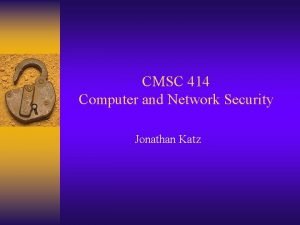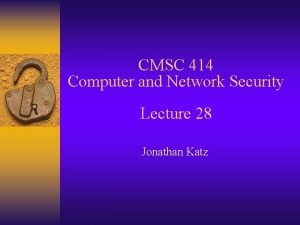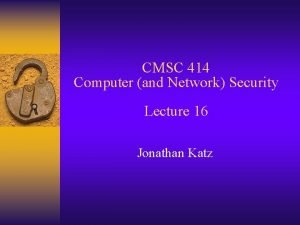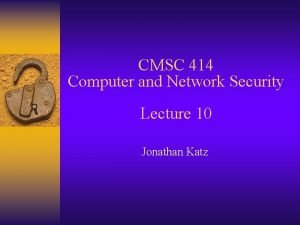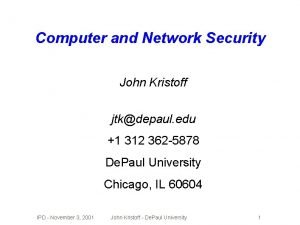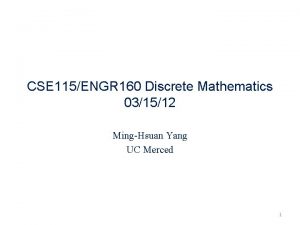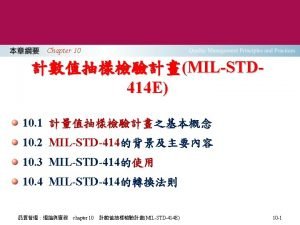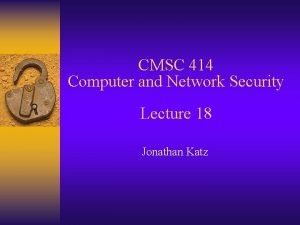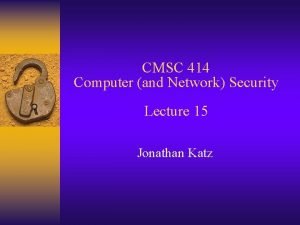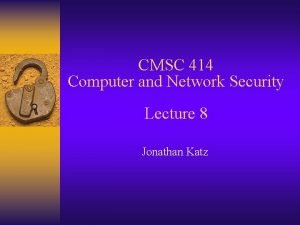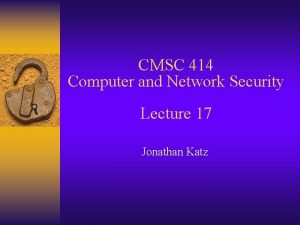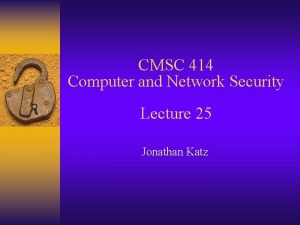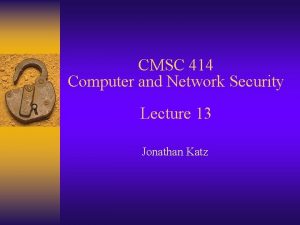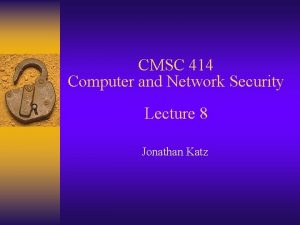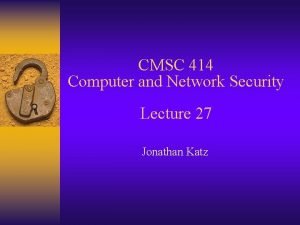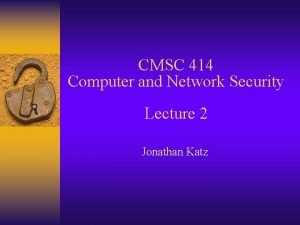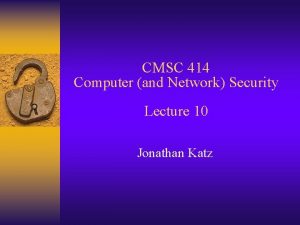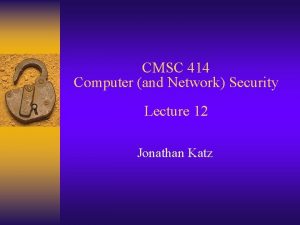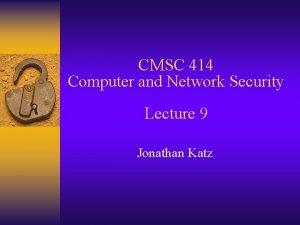CMSC 414 Computer and Network Security Lecture 6

















- Slides: 17

CMSC 414 Computer and Network Security Lecture 6 Jonathan Katz

Authenticating longer messages? ¨ Two widely used schemes (among several): – CBC-MAC – HMAC

CBC-MAC ¨ Fix a message length L n, where the block cipher has n-bit block length ¨ To compute MACk(m 1, …, m. L), with |mi|=n do: – Set t 0 = 0 n – For i=1 to L, set ti : = Fk(ti-1 mi) – Output t. L ¨ To verify, re-compute and check… ¨ Note the similarities to (and differences from) CBC mode encryption

Security of CBC-MAC? ¨ Secure for fixed-length messages ¨ Insecure (as described) for variable-length messages – There are secure variants of CBC-MAC if variablelength messages will be authenticated – Make sure to use these!

HMAC ¨ Can be viewed as a version of “hash-and-MAC”, using collision-resistant hashing…

Hash functions ¨ A (cryptographic) hash function H maps arbitrary length inputs to a fixed-length output ¨ Main goal is collision resistance: – Hard to find distinct x, x’ such that H(x) = H(x’)

Hash functions in practice ¨ MD 5 – 128 -bit output – Introduced in 1991…collision attacks found in 2004…several extensions and improvements to the attacks since then – Still widely deployed(!) ¨ SHA-1 – 160 -bit output – No collisions (yet? ) known, but theoretical attacks exist ¨ SHA-x – 256 -/512 -bit outputs ¨ Competition to design new hash standard in progress

Hash-and-MAC ¨ Hash message to short “digest” ¨ MAC the digest k m H H(m) MAC ¨ HMAC uses essentially this idea t

(Informal) sketch of security ¨ Say the adversary sees tags on m 1, …, mq, , and outputs a valid forgery on m {m 1, …, mq} ¨ Two possibilities: – H(m) = H(mi) for some i collision in H – H(m) {H(m 1), …, H(mq)} forgery in the underlying MAC for short messages

Encryption + integrity ¨ In most settings, confidentiality and integrity are both needed --- i. e. , authenticated encryption – How to obtain both? ¨ Use ‘encrypt-then-authenticate’ ¨ Other natural possibilities are problematic!

What you now know

Sharing keys? ¨ Secure sharing of a key is necessary for private- key crypto – How do parties share a key in the first place? ¨ One possibility is a secure physical channel – E. g. , in-person meeting – Dedicated (un-tappable) phone line – USB stick via courier service ¨ Another possibility: key-exchange protocols – Parties can agree on a key over a public channel – This is amazing! (And began a revolution in crypto…)

Diffie-Hellman key exchange ¨ First, some number theory… – Modular arithmetic, Zp* – Generators: e. g. , 3 is a generator of Z 17*, but 2 is not – The discrete logarithm assumption

The Diffie-Hellman protocol prime p, element g Zp* h. A = gx mod p h. B = gy mod p KAB = (h. B)x KBA = (h. A)y

Security? ¨ Consider security against a passive eavesdropper – We will cover stronger notions of security for key exchange in more detail later in the semester ¨ Under the computational Diffie-Hellman (CDH) assumption, hard for eavesdropper to compute KAB = KBA – Not sufficient for security! – Can hash the key before using ¨ Under the decisional Diffie-Hellman (DDH) assumption, the key KAB looks pseudorandom to an eavesdropper

Technical notes ¨ p and g must be chosen so that the CDH/DDH assumptions hold – Need to be chosen with care – in particular, g should be chosen as a generator of a subgroup of Zp* – Details in CMSC 456 ¨ Can use other groups – Elliptic curves are also popular ¨ Modular exponentiation can be done quickly (in particular, in polynomial time) – But the naïve algorithm does not work!

Security against active attacks? ¨ The basic Diffie-Hellman protocol we have shown is not secure against a ‘man-in-the-middle’ attack ¨ In fact, impossible to achieve security against such attacks unless some information shared in advance – E. g. , private-key setting – Or public-key setting (next) ¨ Will cover authenticated key exchange later
 Cmsc 414
Cmsc 414 Cmsc 414
Cmsc 414 Cmsc 414
Cmsc 414 Cmsc 414
Cmsc 414 Computer security 161 cryptocurrency lecture
Computer security 161 cryptocurrency lecture Wireless security in cryptography and network security
Wireless security in cryptography and network security Private secuirty
Private secuirty Computer and network security
Computer and network security Osi security architecture in network security
Osi security architecture in network security Security guide to network security fundamentals
Security guide to network security fundamentals Electronic mail security in network security
Electronic mail security in network security Security guide to network security fundamentals
Security guide to network security fundamentals Security guide to network security fundamentals
Security guide to network security fundamentals 01:640:244 lecture notes - lecture 15: plat, idah, farad
01:640:244 lecture notes - lecture 15: plat, idah, farad Computer & network security
Computer & network security Gcd of 414 and 662
Gcd of 414 and 662 Network topologies
Network topologies Mil-std-414
Mil-std-414
